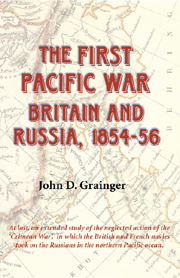Book contents
4 - Petropavlovsk Again
Published online by Cambridge University Press: 12 September 2012
Summary
The Allies' activities in the Pacific during 1854 had been marginal and accidental, with no visible effects on the wider war. The presence of the Russian frigates, which led to the discovery of one of them at Petropavlovsk, had been inadvertent, and the hunt for them had been in large measure an improvisation. The ship the Admiralty had been watching was Diana, but the one which Price discovered was Aurora; he had gone to Petropavlovsk because he seems to have heard in Honolulu that that was where one of the ships he was searching for had gone. All this was quite unplanned.
No serious planning had been undertaken for a war in the North Pacific by anyone, and the neutralisation of Alaska was a sign that neither side had seriously thought that the war would penetrate to that ocean. It was the coincidental presence in the ocean of Admiral Putiatin's naval expedition to Japan – which had set out in response to the news of the American expedition – which in turn triggered Allied activity. It was General Muravev's personal ambitions and his seizure of the Amur route which insisted on the war expanding and continuing in the Pacific. And it was Muravev's mistaken assumption that Britain was interested in controlling the Amur estuary which brought him within range of Allied sea power.
And yet if there was ever an instance of a European crisis driving events all around the world this was one such case.
- Type
- Chapter
- Information
- The First Pacific WarBritain and Russia, 1854–56, pp. 70 - 86Publisher: Boydell & BrewerPrint publication year: 2008



